calsfoundation@cals.org
James William Trimble (1894–1972)
James William Trimble was a Democratic member of the U.S. House of Representatives. He represented the Third District of Arkansas in the Seventy-ninth through the Eighty-ninth Congresses, serving from 1945 to 1967.
James W. Trimble was born in Osage (Carroll County) on February 3, 1894, the oldest of four sons and six daughters born to Allen Trimble and Ana McFarlane Trimble. He attended a variety of rural schools that operated on three-month terms, but he overcame this inconsistent preparation to graduate from high school in Green Forest (Carroll County) in 1913. He then worked his way through the University of Arkansas (UA) in Fayetteville (Washington County) as a janitor, receiving his degree in 1917.
After graduation, Trimble taught history at Texarkana Junior High School in Texarkana (Miller County). Despite having lost his left eye in an accident, he still managed to join the army during World War I and was initially assigned to the adjutant general’s office in Little Rock (Pulaski County). He was about to be sent overseas as a field clerk when the war ended in 1918.
He served as the principal of Osage and Pleasant Ridge (Carroll County) schools before pursuing a legal career. Trimble studied law under Judge H. N. Pittman in Berryville (Carroll County), and after being admitted to the state bar in 1925, he opened a practice of his own in Berryville.
Trimble married Ruth Maples on February 14, 1922, and the couple had a set of twins: a boy, James, and a girl, Martha.
Before beginning his legal career, he had won election as county clerk in 1920 in Carroll County. Sworn in to office in 1921, Trimble served in that post for eight years. He also worked as tax collector for two terms. Trimble served as prosecuting attorney of the fourth judicial circuit of Arkansas from 1930 to 1938 and as judge of that same circuit from 1938 until 1944.
In 1944, Trimble sought election to a seat in the U.S. House of Representatives. Running as a Democrat, seeking to succeed incumbent J. William Fulbright, who was running for the Senate, Trimble won with over sixty percent of the vote, a figure he consistently topped in all of his subsequent ten successful re-election efforts (that is, when he had opposition—he ran unopposed five times). Trimble served first on the Foreign Affairs Committee for two years before moving to Public Works. Later, he was tapped by Speaker Sam Rayburn of Texas to serve on the powerful Rules Committee. He was also chairman of the Special Committee on Chamber Improvements in the Eighty-first and Eighty-second Congresses.
Probably Trimble’s greatest accomplishment as a congressman was the establishment of Pea Ridge National Military Park, getting legislation passed to that effect in 1956. He was also instrumental in expanding rural electrification in the region and providing for improved soil conservation, while also facilitating the development of greater water resources in the region. He was also a strong advocate for education.
Caught in the changing political tides of the era, Trimble was defeated in 1966 by John Paul Hammerschmidt (the first Republican elected to the House from Arkansas since Reconstruction), receiving only forty-seven percent of the vote. After his defeat, Trimble returned to Berryville. He died in Eureka Springs (Carroll County) on March 10, 1972, and is interred in Berryville Memorial Park.
For additional information:
Beckner, Suzanne. “James W. Trimble and His Use of Personal Contact as His Main Campaign Strategy.” Carroll County Historical Quarterly 47 (September 2002): 109–114.
“James William Trimble.” Biographical Directory of the United States Congress. http://bioguide.congress.gov/scripts/biodisplay.pl?index=T000373 (accessed September 16, 2021).
Johnson, Ben F. Arkansas in Modern America since 1930. 2nd ed. Fayetteville: University of Arkansas Press, 2019.
Rothrock, Thomas. “James William Trimble.” Arkansas Historical Quarterly 28 (Spring 1969): 76–85.
William H. Pruden III
Ravenscroft School
 World War II through the Faubus Era, 1941 through 1967
World War II through the Faubus Era, 1941 through 1967 James William Trimble
James William Trimble 




Comments
No comments on this entry yet.